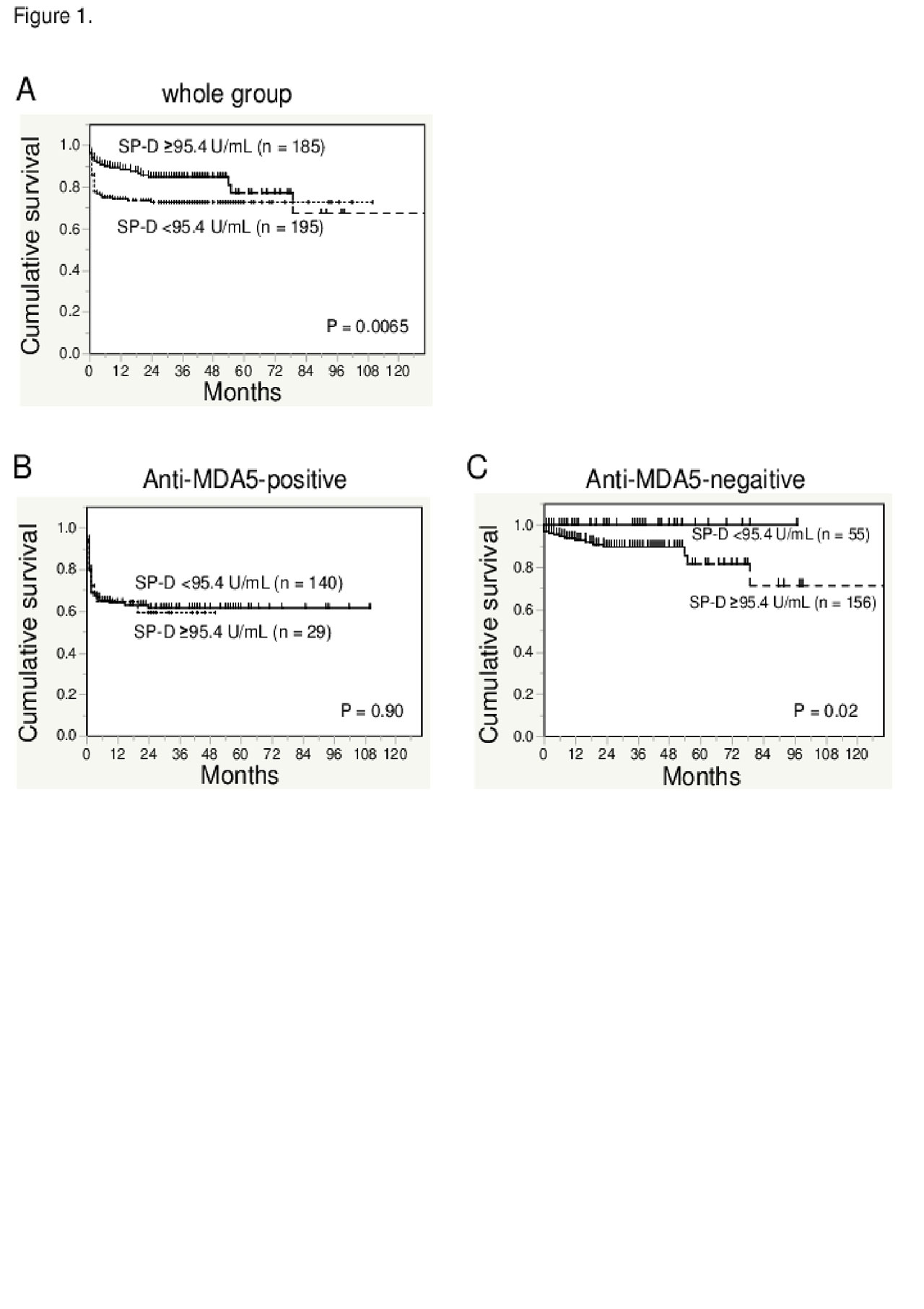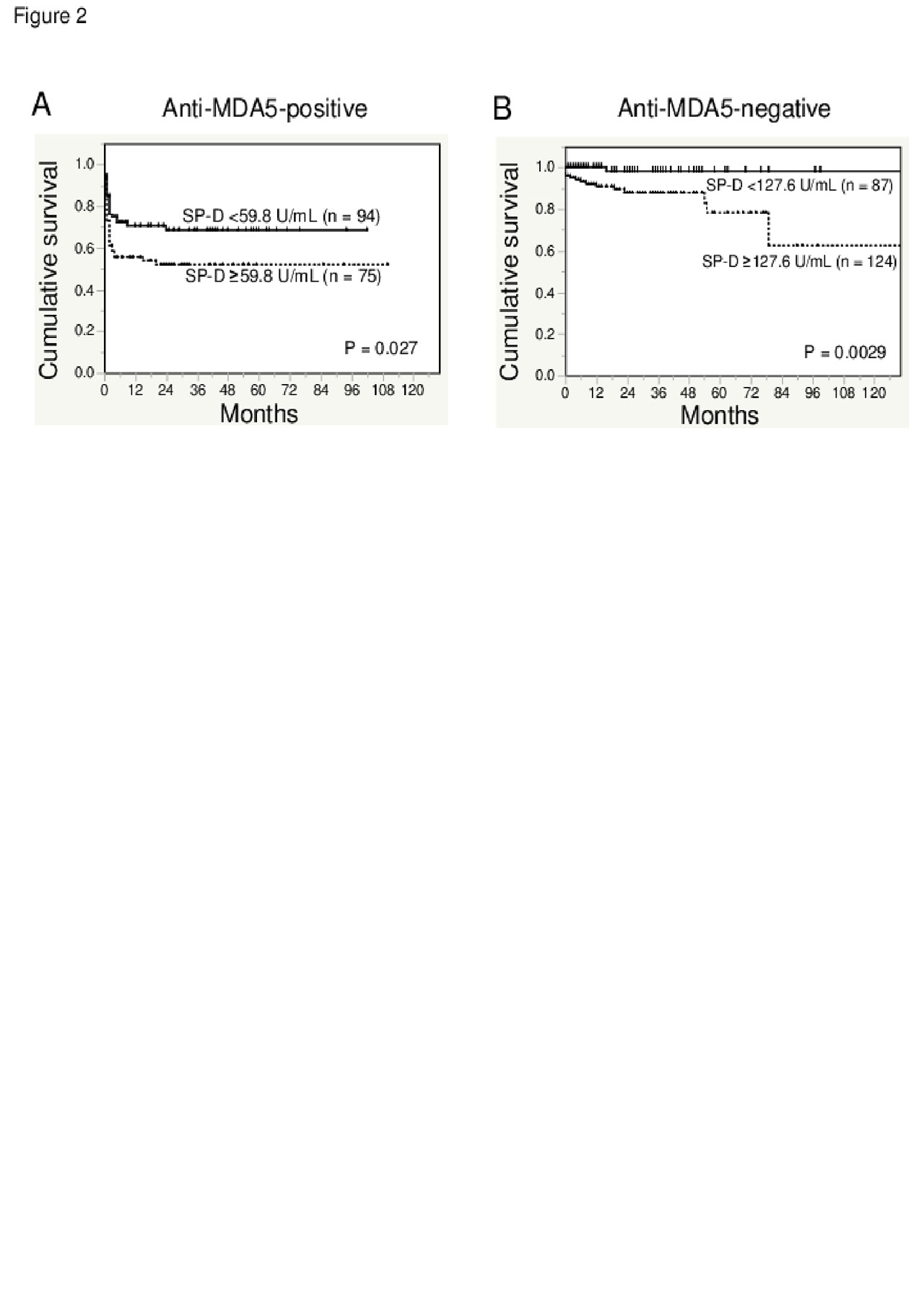Session Information
Session Type: Poster Session (Sunday)
Session Time: 9:00AM-11:00AM
Background/Purpose: Surfactant protein D (SP-D) is considered a serum biomarker of various forms of interstitial lung disease (ILD). However, the usefulness of SP-D for prediction of mortality remained unknown in detail in patients with ILD associated with polymyositis/dermatomyositis (myositis-associated ILD). Thus, we aimed to examine the utility of SP-D as a predictive biomarker for mortality in patients with myositis-associated ILD using our large-scale multicentre cohort data.
Methods: We recently established a multicentre retrospective cohort of Japanese patients with myositis-associated ILD (JAMI), which involved 44 institutions across Japan. We enrolled 381 patients with incident myositis-associated ILD in the JAMI cohort based on the availability of serum SP-D at the baseline. Demographic and clinical characteristics as well as the presence of autoantibodies to melanoma differentiation-associated gene 5 (MDA5) and aminoacyl tRNA synthetase were measured at the time of diagnosis, and follow-up survival data were collected prospectively.
Results: Seventy-eight patients died during the median observation period of 18 months, and the majority of patients died of ILD. The mortality rate was significantly higher (P = 0.0057) in a subset of patients with SP-D < 95.4 ng/mL, the cut-off value estimated by the receiver operating characteristic curve (ROC), than a subset with SP-D ≥95.4 ng/mL. (P = 0.0065; Figure 1A). However, interestingly, the survival curves intersected at 78 months, suggesting a dimorphic role of the SP-D level in the survival of patients with PM/DM-associated ILD:, i.e., short-term mortality was associated with a lower SP-D level, while long-term mortality was associated with a higher SP-D level. Therefore, we divided the enrolled patients into two subsets, anti-MDA5-antibody-positive group and negative group. In anti-MDA5 antibody-positive patients, survival rates were similar between those with SP-D levels at diagnosis < 95.4 ng/mL and ≥95.4 ng/mg (P = 0.90; Figure 1B). In contrast, in anti-MDA5 antibody-negative patients, survival rates were significantly worse in patients with SP-D levels ≥95.4 ng/mL than in those with SP-D levels < 95.4 ng/mL (P = 0.02; Figure 1C). Surprisingly, in anti-MDA5 antibody-negative patients, none of the patients with SP-D levels < 95.4 ng/mL died . In other words, all deceased patients with SP-D level < 95.4 ng/mL were positive for the anti-MDA5 antibody. We re-estimated the optimal cut-off value of SP-D for mortality in anti-MDA5 antibody-positive and anti-MDA5 antibody-negative patients individually with ROC curve analyses, resulting in optimal cut-off levels of 59.8 ng/mL in anti-MDA5 antibody-positive patients (P = 0.027;Figure2A) and 127.6 ng/mL in anti-MDA5 antibody-negative patients ( P = 0.0029;Figure2B).
Conclusion: Serum SP-D is a useful predictor for the prognosis of patients with myositis-associated ILD. We successfully demonstrated the dimorphic role of the SP-D level in the prediction of outcomes on the basis of the presence or absence of anti-MDA5 antibody.
To cite this abstract in AMA style:
Kaieda S, Gono T, Masui K, Nishina N, Sato S, Kuwana M. Surfactant Protein D as a Useful Predictor for Mortality in Myositis-associated Interstitial Lung Disease: A Dimorphic Model Based on anti-MDA5 Antibody [abstract]. Arthritis Rheumatol. 2019; 71 (suppl 10). https://acrabstracts.org/abstract/surfactant-protein-d-as-a-useful-predictor-for-mortality-in-myositis-associated-interstitial-lung-disease-a-dimorphic-model-based-on-anti-mda5-antibody/. Accessed .« Back to 2019 ACR/ARP Annual Meeting
ACR Meeting Abstracts - https://acrabstracts.org/abstract/surfactant-protein-d-as-a-useful-predictor-for-mortality-in-myositis-associated-interstitial-lung-disease-a-dimorphic-model-based-on-anti-mda5-antibody/


